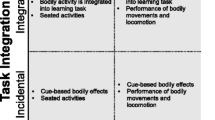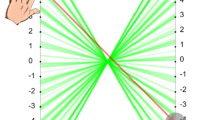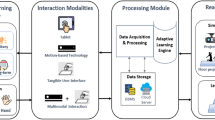Abstract
Situated learning suggests that knowledge is grounded in and influenced by the learning context, the activity, and the culture. Thus, learning in such situated learning contexts can improve learners’ learning performance. Based on embodied cognition and situated learning, this study proposes a situated embodiment-based strategy to help learners learn flag semaphore through real signaling practices with their body movements in a richly perceived learning context. With the support of natural user interface technologies and educational robots, the situated embodiment-based strategy provides a realistic learning context via learners’ body movements to help learners easily construct procedural knowledge. In order to evaluate the effects of the situated embodiment-based strategy, a flag semaphore learning activity was designed and a quasi-experiment was conducted with 60 participants. Three variables were assessed, namely practical signaling performance, attention, and cognitive load. The results showed that the situated embodiment-based learning group had significantly higher practical signaling performance and attention, and significantly lower extrinsic cognitive load than the embodiment-based learning group. The findings suggest that the situated embodiment-based learning strategy is an effective design that can improve the procedural knowledge construction and enhance the attention level with the lower extrinsic cognitive load in a learning process.














Similar content being viewed by others
References
Alavi, M., & Leidner, D. E. (2001). Review: Knowledge management and knowledge management systems: Conceptual foundations and research issues. MIS Quarterly, 25(1), 107–136. doi:10.2307/3250961.
Alibali, M. W., & Nathan, M. J. (2011). Embodiment in mathematics teaching and learning: Evidence from learners’ and teachers’ gestures. Journal of the Learning Sciences, 21(2), 247–286. doi:10.1080/10508406.2011.611446.
Amadieu, F., Mariné, C., & Laimay, C. (2011). The attention-guiding effect and cognitive load in the comprehension of animations. Computers in Human Behavior, 27(1), 36–40. doi:10.1016/j.chb.2010.05.009.
Barsalou, L. W. (1999). Perceptions of perceptual symbols. Behavioral and Brain Sciences, 22(4), 637–660. doi:10.1017/S0140525X99532147.
Barsalou, L. W. (2008). Grounded Cognition. Annual Review of Psychology, 59(1), 617–645. doi:10.1146/annurev.psych.59.103006.093639.
Barsalou, L. W. (2010). Grounded cognition: Past, present, and future. Topics in Cognitive Science, 2(4), 716–724. doi:10.1111/j.1756-8765.2010.01115.x.
Brown, J. S., Collins, A., & Duguid, P. (1989). Situated cognition and the culture of learning. Educational Researcher, 18(1), 32–42. doi:10.3102/0013189x018001032.
Chang, C.-Y., Chien, Y.-T., Chiang, C.-Y., Lin, M.-C., & Lai, H.-C. (2013). Embodying gesture-based multimedia to improve learning. British Journal of Educational Technology, 44(1), E5–E9. doi:10.1111/j.1467-8535.2012.01311.x.
Chang, C.-W., Lee, J.-H., Wang, C.-Y., & Chen, G.-D. (2010). Improving the authentic learning experience by integrating robots into the mixed-reality environment. Computers & Education, 55(4), 1572–1578. doi:10.1016/j.compedu.2010.06.023.
Chao, K.-J., Huang, H.-W., Fang, W.-C., & Chen, N.-S. (2013). Embodied play to learn: Exploring Kinect-facilitated memory performance. British Journal of Educational Technology, 44(5), E151–E155. doi:10.1111/bjet.12018.
Chen, N.-S., & Fang, W.-C. (2014). Gesture-Based technologies for enhancing learning. In R. Huang, Kinshuk & N.-S. Chen (Eds.), The New Development of Technology Enhanced Learning (pp. 95–112). Berlin: Springer. doi: 10.1007/978-3-642-38291-8_6.
Chuang, C.-P., Jou, M., Lin, Y.-T., & Lu, C.-T. (2013). Development of a situated spectrum analyzer learning platform for enhancing student technical skills. Interactive Learning Environments, 1–12. doi: 10.1080/10494820.2013.765896.
Decety, J., & Grèzes, J. (2006). The power of simulation: Imagining one’s own and other’s behavior. Brain Research, 1079(1), 4–14. doi:10.1016/j.brainres.2005.12.115.
Fang, W.-C., Sheu, F.-R., Lin, Y.-L., Lee, Y.-L., & Chen, N.-S. (2015). Interactive physical games: Improving balance in older adults. In M. Chang & Y. Li (Eds.), Smart Learning Environments (pp. 159–174). Berlin: Springer. doi: 10.1007/978-3-662-44447-4_9.
Gagne, E. D., Yekovich, C. W., & Yekovich, F. R. (1997). Cognitive psychology of school learning (2nd ed.). Boston: Allyn & Bacon.
Gardner, H. (1983). Frames of mind: The theory of multiple intelligences. New York: Basic Books.
Goldman, A. I. (2006). Simulating Minds: The Philosophy, Psychology, and Neuroscience of Mindreading. New York: Oxford University Press.
Hao, Y., Hong, J.-C., Jong, J.-T., Hwang, M.-Y., Su, C.-Y., & Yang, J.-S. (2010). Non-native Chinese language learners’ attitudes towards online vision-based motion games. British Journal of Educational Technology, 41(6), 1043–1053. doi:10.1111/j.1467-8535.2009.01050.x.
Hung, I. C., Chao, K.-J., Lee, L., & Chen, N.-S. (2012). Designing a robot teaching assistant for enhancing and sustaining learning motivation. Interactive Learning Environments, 21(2), 156–171. doi:10.1080/10494820.2012.705855.
Hung, I.-C., Lin, L.-I., Fang, W.-C., & Chen, N.-S. (2014). Learning with the body: An embodiment-based learning strategy enhances performance of comprehending fundamental optics. Interacting with Computers, 26(4), 360–371. doi:10.1093/iwc/iwu011.
Kuo, F.-R., Hsu, C.-C., Fang, W.-C., & Chen, N.-S. (2014). The effects of Embodiment-based TPR approach on student English vocabulary learning achievement, retention and acceptance. Journal of King Saud University—Computer and Information Sciences, 26(1, Supplement), 63–70. doi: 10.1016/j.jksuci.2013.10.003.
Landau, M. J., Meier, B. P., & Keefer, L. A. (2010). A metaphor-enriched social cognition. Psychological Bulletin, 136(6), 1045–1067. doi:10.1037/a0020970.
Lave, J., & Wenger, E. (1991). Situated learning: Legitimate peripheral participation. New York: Cambridge University Press.
Macedonia, M., Müller, K., & Friederici, A. D. (2011). The impact of iconic gestures on foreign language word learning and its neural substrate. Human Brain Mapping, 32(6), 982–998. doi:10.1002/hbm.21084.
McNeill, D. (1992). Hand and mind: What gestures reveal about thought. Chicago: University of Chicago Press.
Niedenthal, P. M., Barsalou, L. W., Winkielman, P., Krauth-Gruber, S., & Ric, F. (2005). Embodiment in attitudes, social perception, and emotion. Personality and Social Psychology Review, 9(3), 184–211. doi:10.1207/s15327957pspr0903_1.
Paas, F. G. (1992). Training strategies for attaining transfer of problem-solving skill in statistics: A cognitive-load approach. Journal of Educational Psychology, 84(4), 429–434. doi:10.1037/0022-0663.84.4.429.
Sheu, F.-R., & Chen, N.-S. (2014). Taking a signal: A review of gesture-based computing research in education. Computers & Education, 78, 268–277. doi:10.1016/j.compedu.2014.06.008.
Sheu, F.-R., Lee, Y.-L., Yang, S.-J., & Chen, N.-S. (2015). User-centered design of interactive gesture-based fitness video game for elderly. In G. Chen, V. Kumar, Kinshuk, R. Huang & S. C. Kong (Eds.), Emerging Issues in Smart Learning (pp. 393–397). Berlin: Springer. doi: 10.1007/978-3-662-44188-6_54.
Sweller, J., van Merrienboer, J. G., & Paas, F. W. C. (1998). Cognitive architecture and instructional design. Educational Psychology Review, 10(3), 251–296. doi:10.1023/A:1022193728205.
Wang, Y. H., Young, S. S.-C., & Jang, J.-S. R. (2013). Using tangible companions for enhancing learning English conversation. Journal of Educational Technology & Society, 16(2), 296–309.
Wechsler, D. (1997). Wechsler Adult Intelligence Scale (3rd ed.). San Antonio: The Psychological Corporation.
Young, M. (1993). Instructional design for situated learning. Educational Technology Research and Development, 41(1), 43–58. doi:10.1007/BF02297091.
Acknowledgments
This research was supported by Ministry of Science and Technology in Taiwan under Project Numbers MOST 103-2511-S-110-002-MY3, NSC 102-2911-I-110-501, and NSC 101-2511-S-110-003-MY3.
Author information
Authors and Affiliations
Corresponding author
Rights and permissions
About this article
Cite this article
Hung, IC., Hsu, HH., Chen, NS. et al. Communicating through body: a situated embodiment-based strategy with flag semaphore for procedural knowledge construction. Education Tech Research Dev 63, 749–769 (2015). https://doi.org/10.1007/s11423-015-9386-5
Published:
Issue Date:
DOI: https://doi.org/10.1007/s11423-015-9386-5




